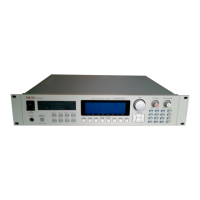EDIT PROGRAM - SINGLE
Page 74 S3000XL Operator’s Manual
LFO1
Pressing will give you this screen display:
This is the page used for setting up LFO1. Again, the program name is shown at the top
right of the screen and other programs may be selected for editing if you wish. The
parameters for LFO1 are as follows:
This allows you to select from three waveforms. They are:
TRIANGLE ( ) - This gives a rising and falling effect. At around a setting
of 75, this would normally be used for vibrato but can be assigned
anywhere you like and can be used for filter sweeps, panning, amplitude
modulation and slow pitch sweeps. This is a ‘bi-polar’ modulation
waveform that ‘rotates’ around the note you are playing to give a natural
vibrato effect.
0
SAWTOOTH ( ) - This waveform is used mostly for special effects. It rises
slowly and falls abruptly. This is a ‘uni-polar’ waveform that jumps between
the held note and the modulation level set at the destination.
0
SQUARE ( ) - This gives stepped ‘up and down’ effect. When applied to
pitch it can be set to give trills or large octave jumps. This is a ‘uni-polar’
waveform that jumps between the held note and the modulation level set
at the destination.
0
RANDOM ( ) - This gives a totally random, stepped waveform and is
suitable for special effects. The effect that immediately springs to mind, of
course, is the classic ‘sample and hold’ effect found on analogue
synthesisers - by routing this to pitch you can create random pitch effects
suitable for, say, creating computer effects, especially when the LFO
speed is set quite fast. When applied to the filter(s), you can create many
interesting random tone change effects. You can even use this wave to
control LFO1’s rate so that not only will pitch, tone or whatever modulation
input this LFO is assigned to be random but the speed of modulation will
change randomly.
This selects whether the LFO’s (all 32 of them!) are synchronised or not.
With ON, all the LFO’s are not synchronised and so give a

